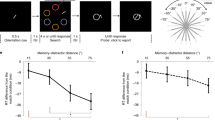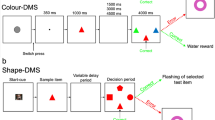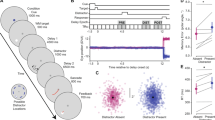Abstract
To determine the specific contribution of brain regions to working memory, human participants performed two distinct tasks on the same visually presented objects. During the maintenance of visual properties, object identity could be decoded from extrastriate, but not prefrontal, cortex, whereas the opposite held for nonvisual properties. Thus, the ability to maintain information during working memory is a general and flexible cortical property, with the role of individual regions being goal-dependent.
This is a preview of subscription content, access via your institution
Access options
Subscribe to this journal
Receive 12 print issues and online access
$209.00 per year
only $17.42 per issue
Buy this article
- Purchase on Springer Link
- Instant access to full article PDF
Prices may be subject to local taxes which are calculated during checkout



Similar content being viewed by others
References
D'Esposito, M. Phil. Trans. R. Soc. Lond. B 362, 761–772 (2007).
Riggall, A.C. & Postle, B.R. J. Neurosci. 32, 12990–12998 (2012).
Christophel, T.B., Hebart, M.N. & Haynes, J.-D. J. Neurosci. 32, 12983–12989 (2012).
Harrison, S.A. & Tong, F. Nature 458, 632–635 (2009).
Serences, J.T., Ester, E.F., Vogel, E.K. & Awh, E. Psychol. Sci. 20, 207–214 (2009).
Linden, D.E.J., Oosterhof, N.N., Klein, C. & Downing, P.E. J. Neurophysiol. 107, 628–639 (2012).
Romero, L., Walsh, V. & Papagno, C. J. Cogn. Neurosci. 18, 1147–1155 (2006).
Lewis-Peacock, J.A. & Postle, B.R. Neuropsychologia 50, 470–478 (2012).
Curtis, C.E. & D'Esposito, M. Trends Cogn. Sci. 7, 415–423 (2003).
Buckner, R.L. & Wheeler, M.E. Nat. Rev. Neurosci. 2, 624–634 (2001).
Kravitz, D.J., Saleem, K.S., Baker, C.I., Ungerleider, L.G. & Mishkin, M. Trends Cogn. Sci. 17, 26–49 (2013).
Kravitz, D.J., Kriegeskorte, N. & Baker, C.I. Cereb. Cortex 20, 2916–2925 (2010).
Funahashi, S., Bruce, C.J. & Goldman-Rakic, P.S. J. Neurophysiol. 61, 331–349 (1989).
Lee, T.G. & D'Esposito, M. J. Neurosci. 32, 15458–15466 (2012).
Sligte, I.G., Van Moorselaar, D. & Vandenbroucke, A.R.E. J. Neurosci. 33, 1293–1294 (2013).
Kravitz, D.J., Saleem, K.S., Baker, C.I. & Mishkin, M. Nat. Rev. Neurosci. 12, 217–230 (2011).
Lee, S.H., Kravitz, D.J. & Baker, C.I. Neuroimage 59, 4064–4073 (2012).
Simmons, W.K. et al. Neuropsychologia 45, 2802–2810 (2007).
Brady, M.J. & Kersten, D. J. Vis. 3, 413–422 (2003).
Van de Moortele, P.-F. et al. Neuroimage 46, 432–446 (2009).
Cox, R.W. Comput. Biomed. Res. 29, 162–173 (1996).
Kriegeskorte, N., Goebel, R. & Bandettini, P. Proc. Natl. Acad. Sci. USA 103, 3863–3868 (2006).
Haxby, J.V. et al. Science 293, 2425–2430 (2001).
Desikan, R.S. et al. Neuroimage 31, 968–980 (2006).
Saad, Z.S. & Reynolds, R.C. Neuroimage 62, 768–773 (2012).
Acknowledgements
This work was supported by the US National Institute of Mental Health Intramural Research Program. Thanks to S. Marrett and S. Inati for help with data acquisition, E. Bilger and E. Aguila for data collection, A. Harel and A. Martin for comments and members of the Laboratory of Brain and Cognition for discussion.
Author information
Authors and Affiliations
Contributions
S.-H.L., D.J.K. and C.I.B. designed the research. S.-H.L. performed the research and analyzed the data. D.J.K. contributed analytic tools. C.I.B. supervised the project. S.-H.L., D.J.K. and C.I.B. wrote the manuscript.
Corresponding author
Ethics declarations
Competing interests
The authors declare no competing financial interests.
Supplementary information
Supplementary Figures and Text
Supplementary Figures 1–5 and Supplementary Table 1 (PDF 3027 kb)
Rights and permissions
About this article
Cite this article
Lee, SH., Kravitz, D. & Baker, C. Goal-dependent dissociation of visual and prefrontal cortices during working memory. Nat Neurosci 16, 997–999 (2013). https://doi.org/10.1038/nn.3452
Received:
Accepted:
Published:
Issue Date:
DOI: https://doi.org/10.1038/nn.3452
This article is cited by
-
Same, Same but Different? A Multi-Method Review of the Processes Underlying Executive Control
Neuropsychology Review (2023)
-
Feature-specific neural reactivation during episodic memory
Nature Communications (2020)
-
Dissociable neural mechanisms underlie currently-relevant, future-relevant, and discarded working memory representations
Scientific Reports (2020)
-
The limited contribution of early visual cortex in visual working memory for surface roughness
Experimental Brain Research (2020)
-
Ensemble representations reveal distinct neural coding of visual working memory
Nature Communications (2019)



